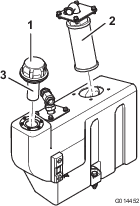| Maintenance Service Interval | Maintenance Procedure |
|---|---|
| Before each use or daily |
|
Introduction
This machine is a ride-on, reel-blade lawn mower intended to be used by professional, hired operators in commercial applications. It is primarily designed for cutting grass on well-maintained turf. Using this product for purposes other than its intended use could prove dangerous to you and bystanders.
Read this information carefully to learn how to operate and maintain your product properly and to avoid injury and product damage. You are responsible for operating the product properly and safely.
Visit www.toro.com/en-gb for more information, including safety tips, training materials, accessory information, help finding a dealer, or to register your product.
Whenever you need service, genuine Toro parts, or additional information, contact an Authorized Service Dealer or Toro Customer Service and have the model and serial numbers of your product ready. Figure 1 identifies the location of the model and serial numbers on the product. Write the numbers in the space provided.
Important: With your mobile device, you can scan the QR code on the serial number decal (if equipped) to access warranty, parts, and other product information.
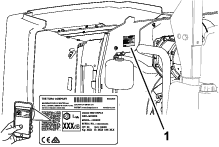
This manual identifies potential hazards and has safety messages identified by the safety-alert symbol (Figure 2), which signals a hazard that may cause serious injury or death if you do not follow the recommended precautions.

This manual uses 2 words to highlight information. Important calls attention to special mechanical information and Note emphasizes general information worthy of special attention.
This product complies with all relevant European directives; for details, please see the separate product specific Declaration of Conformity (DOC) sheet.
Safety
This machine has been designed in accordance with EN ISO 5395.
General Safety
This product is capable of amputating hands and feet and of throwing objects.
-
Read and understand the contents of this Operator’s Manual before starting the engine.
-
Use your full attention while operating the machine. Do not engage in any activity that causes distractions; otherwise, injury or property damage may occur.
-
Do not put your hands or feet near moving components of the machine.
-
Do not operate the machine without all guards and other safety protective devices in place and functioning properly on the machine.
-
Keep bystanders and children out of the operating area. Never allow children to operate the machine.
-
Shut off the engine, remove the key, and wait for all movement to stop before you leave the operator’s position. Allow the machine to cool before adjusting, servicing, cleaning, or storing it.
Improperly using or maintaining this machine can result in injury.
To reduce the potential for injury, comply with these safety instructions
and always pay attention to the safety-alert symbol  , which means
Caution, Warning, or Danger—personal safety instruction. Failure
to comply with these instructions may result in personal injury or
death.
, which means
Caution, Warning, or Danger—personal safety instruction. Failure
to comply with these instructions may result in personal injury or
death.
Safety and Instructional Decals
 |
Safety decals and instructions are easily visible to the operator and are located near any area of potential danger. Replace any decal that is damaged or missing. |

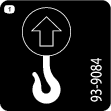

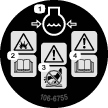
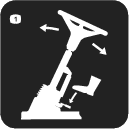



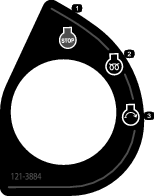
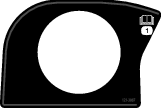
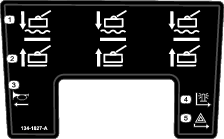

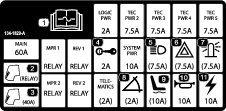
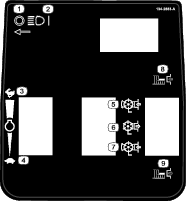

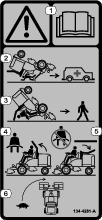



Setup
Store all documentation in a safe place for future use.
Note: Determine the left and right sides of the machine from the normal operating position.
Product Overview
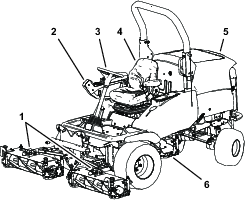
Control Panel Components
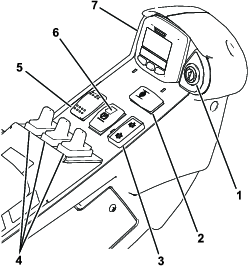
Key Switch
Use the key switch to control the engine and power to certain electrical components.
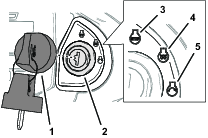
Cutting-Unit-Drive Switch
Use the cutting unit drive to run or shut off the cutting units (Figure 4).
Note: Always put the cutting-unit-drive switch in the OFF position when driving the machine between job sites.
Lift-Control Switches
Use the lift-control switches to raise and lower the cutting units (Figure 4).
Engine-Speed Switch
Use the engine-speed switch to control the speed of the engine.
The engine-speed switch (Figure 4) has 2 modes to change the engine speed.
Momentarily tap the switch to change the engine speed by 100 rpm increments.
Press and hold the switch forward to change the engine to HIGH-IDLE.
Press and hold the switch rearward to change the engine to LOW-IDLE.
Parking-Brake Switch
Warning
The parking brake affects the front wheels only, and may not keep the machine from rolling down a slope. The machine could move unintentionally.
Do not park the machine on a slope.
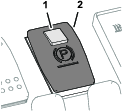
-
To engage the parking brake, slide the small locking button on the top of the switch back and press the switch forward (Figure 6).
Note: The parking brake icon displays in the InfoCenter.
-
To disengage the parking brake, press the switch back.
Service Brake
The hydraulic transmission provides the machine with service-brake effect. When you release the forward or reverse travel pedals or reduce engine speed, the transmission produces service-brake effect and ground speed slows or stops the machine. To increase the transmission-braking effect, push the transmission pedal into the NEUTRAL position. Only the front wheels provide service brake effect.
Danger
The service braking system does not keep the machine from rolling when parked. The machine could move unintentionally.
Engage the parking brake when you park the machine.
Emergency Brake
If the service brake is damaged or ineffective, shut off the engine, engage the parking brake remove the key, and have the machine repaired.
Traction Pedals
Forward travel: Press the forward traction pedal to drive the machine forward and increase ground speed. Release the pedal to reduce ground speed (Figure 7).
Reverse travel: Press the reverse traction pedal to drive the machine backward and increase ground speed. Release the pedal to reduce ground speed (Figure 7).
Stop (Neutral): To stop the machine, use 1 of the following procedures:
-
Reduce your foot pressure on the traction pedal and allow it to return to the neutral position. The machine dynamically brakes to a smooth stop.
-
Tap or hold the reverse pedal briefly. This stops the machine faster than dynamic braking.
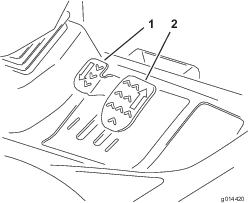
Adjustable Steering Column
Adjust the steering wheel and column only when the machine is parked on level ground.
-
To tilt the steering wheel, press the foot pedal down.
-
Position the steering tower to the most comfortable position and release the pedal (Figure 8).
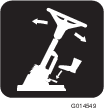
Operator’s Seat Controls
Forward/Backward Adjustment
Move the lever upward to adjust the forward/backward position of the seat. Release the lever to lock the seat in position (Figure 9).
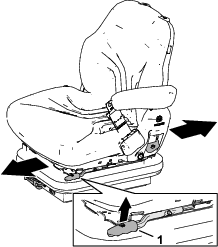
Operator Weight Adjustment
Rotate the handle clockwise to increase suspension stiffness and counterclockwise to decrease the stiffness. The dial indicates when the seat suspension is adjusted for the operator’s weight (kg); refer to Figure 10.
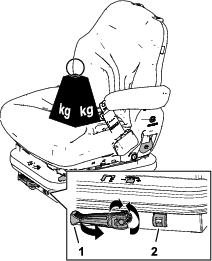
Height Adjustment
To adjust seat height incremental, manually lift the seat. To lower the seat, lift it beyond the highest setting, allow it to drop to the lowest setting, and if needed manually lift the seat to the desired height (Figure 11).
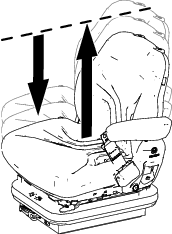
Backrest Adjustment
Pull the handle outward to adjust the seat backrest angle. Release the handle to lock the seat backrest in position (Figure 12).
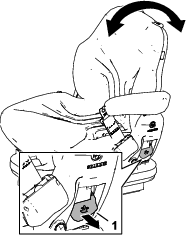
Fuel Gauge
The fuel gauge shows the amount of fuel in the tank (Figure 13).
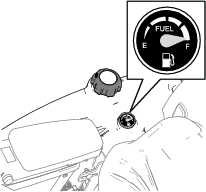
Transport Latches
Front Cutting Unit Arm Latches
Raise the cutting units to the TRANSPORT position and secure the arm-latch pins to the latches with the bails (Figure 14).
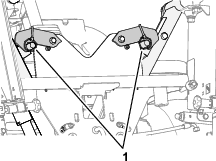
Rear Cutting Unit Arm Latch
Raise the cutting units to the TRANSPORT position, lift the latch arm for the rear cutting-unit arm, and position the arm inboard (Figure 15).
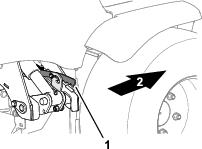
Using the InfoCenter LCD Display
The InfoCenter LCD display shows information about your machine, such as the operating status, various diagnostics, and other information about the machine (Figure 16). There is a splash screen and main information screen of the InfoCenter. You can switch between the splash screen and main information screen at any time by pressing any of the InfoCenter buttons and then selecting the appropriate directional arrow.
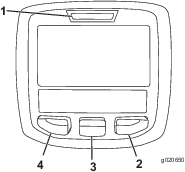
-
Left Button, Menu Access/Back Button—press this button to access the InfoCenter menus. You can use it to exit any menu that you are currently using.
-
Middle Button—use this button to scroll down menus.
-
Right Button—use this button to open a menu where a right arrow indicates additional content.
Note: The purpose of each button may change depending on what is required at the time. Each button is labeled with an icon displaying its current function.
| SERVICE DUE | Indicates when scheduled service should be performed |
 | Hours remaining until service |
 | Reset the service hours.  |
 | The status of the engine speed (rpm)—InfoCenter display in languages other than English |
 | The status of the engine speed (rpm)—InfoCenter display in English |
 | Info icon |
 | Stationary regeneration is required. |
 | The air-intake heater is active. |
 | The operator must sit in the seat. |
 | The parking brake is engaged. |
 | Neutral |
 | Coolant temperature (°C or °F) |
 | Temperature (hot) |
 | Not allowed |
 | Start the engine. |
 | The PTO is on. |
 | Shut off the engine. |
 | Engine |
 | Key switch |
 | Cutting units are lowering |
 | Cutting units are raising |
 | CAN bus |
 | InfoCenter |
 | Bad or failed |
 | Center |
 | Right |
 | Left |
 | Bulb |
 | Output of TEC controller or control wire in harness |
 | Switch |
 | Operator must release switch |
 | Operator should change to indicated state |
| Symbols are often combined to form sentences. Some examples are shown below. | |
 | Operator should put machine in neutral |
 | Engine start is denied |
 | Engine shutdown |
 | Engine coolant is too hot |
 | DPF ash accumulation notification. Refer to Servicing the Diesel Particulate Filter (DPF) in the maintenance section for details |
 | Reset-standby regeneration request |
| Parked or recovery regeneration request | |
 | A parked or recovery regeneration is processing. |
 | High exhaust temperature |
 | NOx control diagnosis malfunction; drive the machine back to the shop and contact your authorized Toro distributor (software version U and later). |
 | The power take-off is disabled. |
 | Sit down or engage the parking brake. |
 |
Indicates that limited lift reverse is active. |
 Accessible
only by entering PIN
Accessible
only by entering PIN
Using the Menus
To access the InfoCenter menu system, press the menu access button while at the main screen. This displays the main menu. Refer to the following tables for a synopsis of the options available from the menus:
|
Menu Item |
Description |
|---|---|
|
Faults |
Contains a list of the recent machine faults. Refer to the Service Manual or your authorized Toro distributor for more information on the Faults menu and the information contained there. |
|
Diagnostics |
Lists various states that the machine currently has; you can use this to troubleshoot certain issues as it quickly tells you which machine controls are on and which are off. |
|
Service |
Contains information on the machine such as hours of use, counters, and other similar numbers. |
|
Settings |
Allows you to customize and modify configuration variables on the InfoCenter display. |
|
About |
Lists the model number, serial number, and software version of your machine. |
|
Menu Item |
Description |
|---|---|
|
Hours |
Lists the total number of hours that the machine, engine, and PTO have been on, as well as the number of hours the machine has been transported and service due |
|
Counts |
Lists numerous counts the machine experienced |
|
DPF Regeneration |
The diesel particulate filter regeneration option and DPF submenus |
|
Backlap |
Use to turn backlap on or off |
|
Inhibit Regen |
Use to control reset regeneration |
|
Parked Regen |
Use to initiate a parked regeneration |
|
Last Regen |
Lists the number hours since the last reset, parked, or recovery regeneration |
|
Recover Regen |
Use to initiate a recovery regeneration |
|
Menu Item |
Description |
|---|---|
|
Units |
Controls the units used on the InfoCenter (English or Metric) |
|
Language |
Controls the language used on the InfoCenter* |
|
LCD Backlight |
Controls the brightness of the LCD display |
|
LCD Contrast |
Controls the contrast of the LCD display |
|
Protected Menus |
Allows an authorized person with the PIN code to access protected menus |
|
Protect Settings |
Allows the ability to change the settings in the protected settings |
|
Limited Lift Reverse |
Turns on or off limited lift reverse |
|
Slope Sensor Installed |
Indicates a slope sensor is detected in the machine. |
|
Turnaround |
Turns on or off turnaround for cutting units |
|
|
|
|
Menu Item |
Description |
|---|---|
|
Model |
Lists the model number of the machine |
|
SN |
Lists the serial number of the machine |
|
Machine Controller Revision |
Lists the software revision of the master controller |
|
InfoCenter Revision |
Lists the software revision of the InfoCenter |
|
CAN Bus | Lists the machine communication bus status |
|
|
|
|
Menu Item |
Description |
|---|---|
|
Engine Run |
Refer to the Service Manual or your authorized Toro distributor for more information on the Engine Run menu and the information contained there. |
|
Decks Raise |
|
|
Decks Lower |
|
|
PTO |
|
|
Traction |
Protected Menus
There are operating configuration settings that are adjustable within the Settings Menu of the InfoCenter. To lock these settings, use the Protected Menu.
Note: At the time of delivery, the initial password code is programmed by your authorized Toro distributor.
Accessing Protected Menus
Note: The factory default PIN code for your machine is either 0000 or 1234.If you changed the PIN code and forgot the code, contact your authorized Toro distributor for assistance.
-
From the MAIN MENU, use the center button to scroll down to the SETTINGS MENU and press the right button (Figure 17).
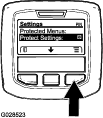
-
In the SETTINGS MENU, use the center button to scroll down to the PROTECTED MENU and press the right button (Figure 18A).
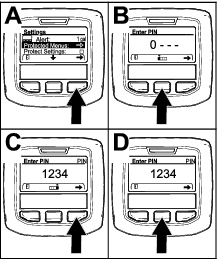
-
To enter the PIN code, press the center button until the correct first digit appears, then press the right button to move on to the next digit (Figure 18B and Figure 18C). Repeat this step until the last digit is entered and press the right button once more.
-
Press the middle button to enter the PIN code (Figure 18D).
Wait until the red indicator light of the InfoCenter illuminates.
Note: If the InfoCenter accepts the PIN code and the protected menu is unlocked, the word “PIN” displays in the upper right corner of the screen.
Note: Rotate the key switch to the OFF position and then to the ON position locks the protected menu.
You can view and change the settings in the Protected Menu. Once you access the Protected Menu, scroll down to Protect Settings option. Use the right button to change the setting. Setting the Protect Settings to OFF allows you to view and change the settings in the Protected Menu without entering the PIN code. Setting the Protect Settings to ON hides the protected options and requires you to enter the PIN code to change the setting in the Protected Menu. After you set the PIN code, rotate the key switch OFF and back to the ON position to enable and save this feature.
Viewing and Changing the Protected Menu Settings
In the Protected Menu, scroll down to Protect Settings and perform 1 of the following:
-
To view and change the settings without entering a PIN code, and use the right button to change the Protect Settings to OFF.
-
To view and change the settings with a PIN code, use the left button to change the Protect Settings to ON, set the PIN code, and turn the key in the ignition switch to the OFF position and then to the ON position.
| Specification | LT3340 |
|---|---|
| Transport Width | 157.5 cm (62 inches) |
| Width of cut | 76 cm (30 inches) to 212 cm (83.5 inches) |
| Height of cut | 13 mm (1/2 inch) to 76 mm (3 inches) |
| Length (including front cutting units) | 289 cm (114 inches) |
| Height | 168 cm (66.2 inches) with ROPS down |
| 216 cm (85.0 inches) with ROPS up | |
| 209 cm (82.3 inches) with cab | |
| Weight (with 250 mm, 6-blade cutting units; without fuel or accessories) | 1427 kg (3,146 lb) with ROPS |
| 1627 kg (3,587 lb) with cab | |
| Engine | Yanmar 3TNV88C; 27.5 kw (37 hp) at 3,000 rpm |
| Fuel tank capacity | 60 L (15.9 US gallons) |
| Transport speed | 25 km/h (15.5 mph) |
| Mowing speed | 11 km/h (6.85 mph) |
| Hydraulic system capacity | 32 L (8.5 US gallons) |
| Engine speed | 3000 rpm |
| Reel speed | 1000 rpm |
Note: Specifications and design are subject to change without notice.
Attachments/Accessories
A selection of Toro approved attachments and accessories is available for use with the machine to enhance and expand its capabilities. Contact your Authorized Service Dealer or authorized Toro distributor or go to www.toro.com/en-gb for a list of all approved attachments and accessories.
To ensure optimum performance and continued safety certification of the machine, use only genuine Toro replacement parts and accessories. Replacement parts and accessories made by other manufacturers could be dangerous, and such use could void the product warranty.
Operation
Before Operation
Before Operation Safety
General Safety
-
Never allow children or untrained people to operate or service the machine. Local regulations may restrict the age of the operator. The owner is responsible for training all operators and mechanics.
-
Become familiar with the safe operation of the equipment, operator controls, and safety signs.
-
Shut off the engine, remove the key, and wait for all movement to stop before you leave the operator’s position. Allow the machine to cool before adjusting, servicing, cleaning, or storing it.
-
Know how to stop the machine and shut off the engine quickly.
-
Do not operate the machine without all guards and other safety protective devices in place and functioning properly on the machine.
-
Before mowing, always inspect the machine to ensure that the cutting units are in good working condition.
-
Inspect the area where you will use the machine and remove all objects that the machine could throw.
Fuel Safety
-
Use extreme care in handling fuel. It is flammable and its vapors are explosive.
-
Extinguish all cigarettes, cigars, pipes, and other sources of ignition.
-
Use only an approved fuel container.
-
Do not remove the fuel cap or fill the fuel tank while the engine is running or hot.
-
Do not add or drain fuel in an enclosed space.
-
Do not store the machine or fuel container where there is an open flame, spark, or pilot light, such as on a water heater or other appliance.
-
If you spill fuel, do not attempt to start the engine; avoid creating any source of ignition until the fuel vapors have dissipated.
Performing Daily Maintenance
Before starting the machine each day, perform the Each Use/Daily procedures listed in .
Filling the Fuel Tank
Fuel Tank Capacity
60 L (15.9 US gallons)
Fuel Specification
Important: Use only ultra-low sulphur diesel fuel. Fuel with higher rates of sulfur degrades the diesel oxidation catalyst (DOC), which causes operational problems and shortens the service life of engine components.Failure to observe the following cautions may damage the engine.
-
Never use kerosene or gasoline instead of diesel fuel.
-
Never mix kerosene or used engine oil with the diesel fuel.
-
Never keep fuel in containers with zinc plating on the inside.
-
Do not use fuel additives.
Petroleum Diesel
Cetane rating: 45 or higher
Sulfur content: Ultra-low sulfur (<15 ppm)
| Diesel fuel specification | Location |
| ASTM D975 | USA |
| No. 1-D S15 | |
| No. 2-D S15 | |
| EN 590 | European Union |
| ISO 8217 DMX | International |
| JIS K2204 Grade No. 2 | Japan |
| KSM-2610 | Korea |
-
Use only clean, fresh diesel fuel or biodiesel fuels.
-
Purchase fuel in quantities that can be used within 180 days to ensure fuel freshness.
Use summer-grade diesel fuel (No. 2-D) at temperatures above -7°C (20°F) and winter-grade fuel (No. 1-D or No. 1-D/2-D blend) below that temperature.
Note: Use of winter-grade fuel at lower temperatures provides lower flash point and cold flow characteristics which eases starting and reduces fuel filter plugging.Using summer-grade fuel above -7°C (20°F) contributes toward longer fuel pump life and increased power compared to winter-grade fuel.
Biodiesel
This machine can also use a biodiesel blended fuel of up to B20 (20% biodiesel, 80% petroleum diesel).
Sulfur content: Ultra-low sulfur (<15 ppm)
Biodiesel fuel specification: ASTM D6751 or EN14214
Blended fuel specification: ASTM D975, EN590, or JIS K2204
Important: The petroleum diesel portion must be ultra-low sulfur.
Observe the following precautions:
-
Biodiesel blends may damage painted surfaces.
-
Use B5 (biodiesel content of 5%) or lesser blends in cold weather.
-
Monitor seals, hoses, gaskets in contact with fuel as they may be degraded over time.
-
Fuel filter plugging may be expected for a time after converting to biodiesel blends.
-
Contact your authorized Toro distributor for more information on biodiesel.
Adding Fuel
-
Park the machine on a level surface, lower the cutting units, shut off the engine, engage the parking brake, and remove the key.
-
Using a clean rag, clean area around fuel-tank cap.
-
Remove the cap from the fuel tank (Figure 19).
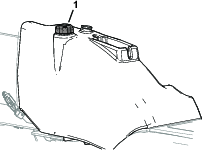
-
Fill the tank until the level is 25 mm (1 inch) below the bottom of the filler neck.
-
Install the fuel-tank cap tightly after filling the tank.
Note: If possible, fill the fuel tank after each use. This minimizes possible buildup of condensation inside the fuel tank.
Checking the Forward/Reverse Traction Pedal Action
With the engine shut off, operate the forward and reverse traction pedals through the full range of articulation and ensure that the mechanism returns freely to the NEUTRAL position.
Checking the Interlock Switches
| Maintenance Service Interval | Maintenance Procedure |
|---|---|
| Before each use or daily |
|
Checking the Operator Presence Seat Switch
-
Sit on the operator’s seat and start the engine.
-
Lower the cutting units to the ground.
-
Set the cutting-unit-drive switch to the forward-cut position.
-
Rise from the operator’s seat and check that the cutting units stop after an initial 0.5 to 1 second delay.
-
Repeat steps 1 through 4 with the cutting-unit-drive switch in the reverse position.
Checking the Cutting-Unit Drive Interlock Switch
-
Shut off the engine.
-
Set the cutting-unit-drive switch to the OFF position and turn the ignition key to preheat-run position
 .
The PTO icon
.
The PTO icon  should not display in the InfoCenter.
should not display in the InfoCenter. -
Set the cutting-unit-drive switch to the forward-cut position. The PTO icon
 displays, but the engine should not start when
you rotate the ignition key to the START position
displays, but the engine should not start when
you rotate the ignition key to the START position  .
. -
Set the cutting-unit-drive switch to the reverse position. The PTO icon
 displays, but the engine should not start when you rotate the ignition
key to the START position
displays, but the engine should not start when you rotate the ignition
key to the START position  .
.
Checking the Parking Brake Interlock Switch
-
Shut off the engine.
-
Engage the parking brake.
-
Rotate the ignition key to the preheat-run position
 . The parking-brake switch
illuminates and the parking brake icon
. The parking-brake switch
illuminates and the parking brake icon  displays in the InfoCenter.
displays in the InfoCenter. -
Disengage the parking brake; the parking brake light and icon shut off. The engine should not start when you rotate the ignition key to the START position
 .
. -
Engage the parking brake, sit on the operator’s seat, and start the engine.
-
Disengage the parking brake.
-
Rise from the operator seat’s and check that the engine shuts off.
Checking the Transmission Neutral Interlock Switch
Important: Take extreme care to ensure that the area around the machine is clear before checking that the engine does not start when checking the neutral interlock switch.
-
Shut off the engine.
-
Remove your foot from the forward/reverse travel pedals.
-
Turn the ignition key to preheat-run position
 . The transmission neutral
icon
. The transmission neutral
icon  displays
in the InfoCenter.
displays
in the InfoCenter. -
Apply light pressure to the travel pedals in a forward and reverse direction to check that the transmission neutral icon is not displayed in the InfoCenter.
During Operation
During Operation Safety
General Safety
-
The owner/operator can prevent and is responsible for accidents that may cause personal injury or property damage.
-
Wear appropriate clothing, including eye protection; long trousers; substantial, slip-resistant footwear; and hearing protection. Tie back long hair and do not wear loose clothing or loose jewelry.
-
Do not operate the machine while ill, tired, or under the influence of alcohol or drugs.
-
Use your full attention while operating the machine. Do not engage in any activity that causes distractions; otherwise, injury or property damage may occur.
-
Before you start the engine, ensure that all drives are in neutral, the parking brake is engaged, and you are in the operating position.
-
Do not carry passengers on the machine and keep bystanders and children out of the operating area.
-
Operate the machine only in good visibility to avoid holes or hidden hazards.
-
Avoid mowing on wet grass. Reduced traction could cause the machine to slide.
-
Keep your hands and feet away from the cutting units.
-
Look behind and down before backing up to be sure of a clear path.
-
Use care when approaching blind corners, shrubs, trees, or other objects that may obscure your vision.
-
Stop the cutting units whenever you are not mowing.
-
Slow down and use caution when making turns and crossing roads and sidewalks with the machine. Always yield the right-of-way.
-
Operate the engine only in well-ventilated areas. Exhaust gases contain carbon monoxide, which is lethal if inhaled.
-
Do not leave a running machine unattended.
-
Before you leave the operator’s position, do the following:
-
Park the machine on a level surface.
-
Disengage the cutting unit(s) and lower the attachments.
-
Engage the parking brake.
-
Shut off the engine and remove the key.
-
Wait for all movement to stop.
-
-
Operate the machine only in good visibility and appropriate weather conditions. Do not operate the machine when there is the risk of lightning.
Rollover Protection System (ROPS) Safety
-
Do not remove any of the ROPS components from the machine.
-
Ensure that the seat belt is attached and that you can release it quickly in an emergency.
-
Always wear your seat belt.
-
Check carefully for overhead obstructions and do not contact them.
-
Keep the ROPS in safe operating condition by thoroughly inspecting it periodically for damage and keeping all the mounting fasteners tight.
-
Replace all damaged ROPS components. Do not repair or alter them.
Machines with a Foldable Roll Bar
-
Always use the seat belt with the roll bar in the raised position.
-
The ROPS is an integral safety device. Keep a folding roll bar in the raised and locked position, and use the seat belt when operating the machine with the roll bar in the raised position.
-
Lower a folding roll bar temporarily only when necessary. Do not wear the seat belt when the roll bar is folded down.
-
Be aware that there is no rollover protection when a folded roll bar is in the down position.
-
Check the area that you will be mowing and never fold down a folding roll bar in areas where there are slopes, drop-offs, or water.
Slope Safety
-
Slopes are a major factor related to loss of control and rollover accidents, which can result in severe injury or death. You are responsible for safe slope operation. Operating the machine on any slope requires extra caution.
-
Evaluate the site conditions to determine if the slope is safe for machine operation, including surveying the site. Always use common sense and good judgment when performing this survey.
-
Review the slope instructions, listed below, for operating the machine on slopes. Before you operate the machine, review the site conditions to determine whether you can operate the machine in the conditions on that day and at that site. Changes in the terrain can result in a change in slope operation for the machine.
-
Avoid starting, stopping, or turning the machine on slopes. Avoid making sudden changes in speed or direction. Make turns slowly and gradually.
-
Do not operate a machine under any conditions where traction, steering, or stability is in question.
-
Remove or mark obstructions such as ditches, holes, ruts, bumps, rocks, or other hidden hazards. Tall grass can hide obstructions. Uneven terrain could overturn the machine.
-
Be aware that operating the machine on wet grass, across slopes, or downhill may cause the machine to lose traction.
-
Use extreme caution when operating the machine near drop-offs, ditches, embankments, water hazards, or other hazards. The machine could suddenly roll over if a wheel goes over the edge or the edge caves in. Establish a safety area between the machine and any hazard.
-
Identify hazards at the base of the slope. If there are hazards, mow the slope with a pedestrian-controlled machine.
-
If possible, keep the cutting units lowered to the ground while operating on slopes. Raising the cutting units while operating on slopes can cause the machine to become unstable.
-
Understanding the Operator Presence Controls
Caution
If safety interlock switches are disconnected or damaged the machine could operate unexpectedly causing, personal injury.
-
Do not tamper with the interlock switches.
-
Check the operation of the interlock switches daily and replace any damaged switches before operating the machine.
Important: Do not operate the machine if the operator presence controls are damaged or worn. Always replace damaged or worn parts, and check that operator presence controls function correctly before operating the machine.
Engine Start Interlock
You can start the engine only when the forward/reverse travel pedal is in the NEUTRAL position, the cutting-unit-drive switch is in the OFF position, and the parking brake is engaged.
Note: You can start the engine only when the cutting-unit-drive switch is in the OFF position.
Engine Run Interlock
Once you start the engine, you must sit in the operator’s seat to run the engine while the parking brake is disengaged.
The engine shuts off if you leave the operator’s seat without first engaging the parking brake.
Cutting Unit Drive Interlock
You must sit in the operator’s seat to run the cutting units. If you raise off the seat for more than a second, a switch activates and the drive to the cutting units disengages.
To reset the cutting units, sit in the seat, move the cutting-unit-drive switch to the OFF position, and then move the switch to the ON position.
Note: If you briefly raise off the seat during normal work, drive to the cutting units is not affected.
Adjusting the Roll Bar
Warning
To avoid injury or death from rollover, keep the roll bar in the raised locked position and use the seat belt.
Ensure that the seat is secured with the seat latch.
Warning
There is no rollover protection when the roll bar is in the down position.
-
Do not operate the machine on uneven ground or on a hill side with the roll bar in the down position.
-
Lower the roll bar only when absolutely necessary.
-
Do not wear the seat belt when the roll bar is in the down position.
-
Drive slowly and carefully.
-
Raise the roll bar as soon as clearance permits.
-
Check carefully for overhead clearances (i.e., branches, doorways, electrical wires) before driving under any objects and do not contact them.
Important: Always use the seat belt when the roll bar is in the raised and locked position. Do not use the seat belt when the roll bar is in the lowered position.
Lowering the Roll Bar
-
Park the machine on a level surface, lower the cutting units, engage the parking brake, shut off the engine, and remove the key.
-
Remove the hairpins from the roll-bar pins in the pivot brackets of the lower roll-bar frame (Figure 20).
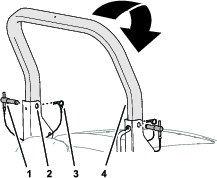
-
While supporting the weight of the upper roll bar, remove the roll-bar pins from the pivot brackets (Figure 20).
-
Carefully lower the upper roll bar until it rests on the stops of the lower roll-bar frame.
-
Insert the roll-bar pins in the lower holes of the pivot brackets (Figure 21).
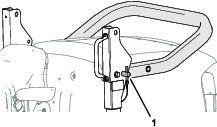
-
Secure roll-bar pins to the pivot brackets with the hairpins.
Raising the Roll Bar
-
Remove the hairpins that secure the roll-bar pins to the pivot brackets of the lower roll-bar frame.
-
Remove the roll-bar pins to the pivot brackets (Figure 22).

-
Raise the upper roll bar until the holes in the roll bar align with the pivot brackets (Figure 23).
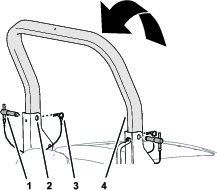
-
Insert the roll-bar pins through the upper holes of the pivot brackets and the upper roll bar (Figure 23).
-
Secure roll-bar pins to the pivot brackets with the hairpins (Figure 23).
Starting the Engine
Important: If you are starting the engine for the first time, the engine has stopped from lack of fuel, or you performed fuel system maintenance, bleed the fuel system before starting the engine; refer to Priming the Fuel System.
Important: This machine is fitted with an engine start lockout; refer to Understanding the Operator Presence Controls.
-
Engage the parking brake, move the traction pedal to the NEUTRAL position, and ensure that the cutting unit drive switch is in the OFF position.
-
Turn the key to the INTAKE HEATER/RUN POSITION position.
Note: The pre-heat indicator icon
 displays in the InfoCenter. Wait until the pre-heat
indicator icon no longer displays.
displays in the InfoCenter. Wait until the pre-heat
indicator icon no longer displays.
-
Rotate the key to the start position.
When the engine starts, release the key to the intake heater/run position.
Important: Crank the engine for no longer than 15 seconds.
-
Run the engine at low idle speed until it warms up.
Shutting Off the Engine
Important: Allow the engine to idle for 5 minutes before shutting it off after a full-load operation. This allows the turbocharger to cool down before shutting off the engine. Failure to idle the engine may damage the turbocharger.
-
Move the traction pedal to the NEUTRAL position, shut off the cutting unit drive switch, engage the parking brake, and lower the cutting units.
-
Press the engine speed switch until the engine speed is at low idle.
-
Let the engine run for at least 5 minutes.
-
Turn the key to shutoff (stop) position (Figure 25).

-
Remove the key before you leave the operator’s seat.
Using the Cutting Units
Adjusting the Grass Deflectors
Adjust the rear grass deflectors as low as possible so that grass clippings discharge to the ground without restricting clippings exiting cutting unit (Figure 26).
Note: Always position the rear grass deflectors correctly.
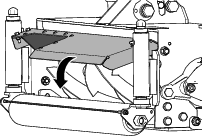
Adjusting the Center Cutting Unit Height-of-Cut Correction
With all cutting units set at the same HOC as shown by the indicator rings, you may notice that the center cutting unit produces a higher cut finish compared to that of the left and right cutting units. The machine pulls the center cutting unit whereas the left and right cutting units are pushed; this affects the cutting unit angle relative to the ground. The amount of HOC variation that results from this effect is also influenced by the terrain, but you can achieve satisfactory results by setting the center cutting unit HOC indicator ring lower than the left and right cutting unit settings.
Controlling the Position of the Individual Cutting Units
Use the 3 lift-control switches to raise or lower the cutting units independently.
Lowering the Cutting Unit
-
Press the cutting-unit-drive switch to the FORWARD ROTATION position.
-
Press the lift-control switch forward and release.
Note: The cutting unit engages when it is approximately 150 mm (6 inches) above ground level. The cutting unit is in ‘float’ mode, and follows the ground contours.
Note: The lift-control switch automatically returns to the (NEUTRAL) position when you release it.
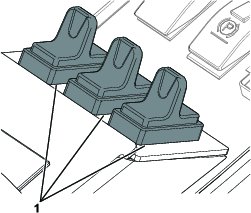
Raising the Cutting Unit
-
Pull and hold the lift-control switch.
-
Release the lift-control switches when the cutting units are at the needed height.
Note: The lift-control switches automatically return to the (NEUTRAL) position when you release it and the cutting unit arms hydraulically lock into position.
Cutting Unit Limited-Lift Position
Limiting Cutting Unit Lift When Driving Forward
Note: The limited lift function for driving forward is enabled by default.
-
While driving forward, momentarily pull the lift-control switch(s).
Note: The cutting unit(s) shuts off and it raises approximately 150 mm (6 inches) above ground level.
-
The limited lift function shuts off when the cutting unit is lowered and running.
Limiting Cutting Unit Lift When Driving Backward
Note: You must enable the limited-lift function in the InfoCenter to automatically lift the cutting units when driving backward.
-
When the limited-lift function is enabled, driving the machine backward causes all cutting units raise to the limited-lift position.
Note: The cutting unit(s) raises approximately 150 mm (6 inches) above ground level.
Important: The cutting units continue to run while using limited lift and driving the machine backward.
-
Driving the machine forward again causes the cutting unit lower to the float position.
Using the Cutting-Unit Turnaround Feature
Note: You must enable the turnaround feature for the center lift-control switch in the settings menu of the InfoCenter.
-
Momentarily pull the lift-control switch for the center cutting unit to raise all cutting units to the limited lift position.
-
Momentarily push down the lift-control switch for the center cutting unit to lower all cutting units to the float position.
Adjusting the Cutting Unit Auto-Limited Lift
Note: You enable the cutting-unit Auto Limited Lift feature in the settings menu of the InfoCenter.
-
Manual limited lift uses the 3 lift-control switches, and is always available regardless of auto-limited lift setting in the InfoCenter.
-
When cutting-unit Auto Limited Lift is enabled, driving the machine in reverse causes the cutting units to automatically raise to the limited-lift position.
-
The cutting units return to the floating position when driving the machine forward.
To raise the cutting units to the limited-lift position, momentarily pull the lift-control switches.
Note: The cutting-unit drives disengage immediately, and the cutting units raise to approximately 150 mm (6 inches) above ground level.
Auto-limited lift operates with the cutting units lowered and rotating.
Cutting Unit Drive
The cutting unit drive engages only when you sit in the operator’s seat; refer toChecking the Operator Presence Seat Switch.
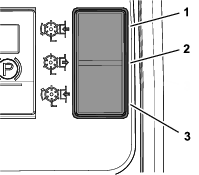
Engaging the Cutting Unit Drive for Forward Rotation
Press the top of the cutting unit drive switch to the forward rotation position (Figure 28).
Engaging the Cutting Unit Drive for Reverse Rotation
Press the bottom of the cutting unit drive switch to the reverse rotation position (Figure 28).
Disengaging All Cutting Unit Drives
Press the cutting unit drive switch to the middle position (Figure 28).
Lowering the Cutting Units
Press the cutting unit drive switch to the forward rotation position. Press the lift-control switch(s) to the LOWER position. The cutting units run when the they are approximately 150 mm (6 inches) above ground level.
Adjusting the Weight Transfer/Traction Assistance
A variable hydraulic weight transfer system provides improved tire grip with the grass surface—traction assistance.
Hydraulic pressure from the cutting-unit lift system provides a lifting force that reduces the weight of the cutting units on the ground and transfers the weight downward to the tires. This action is known as weight transfer.
Note: Adjust the amount of weight transfer to suit operating conditions.
-
Open the hood.
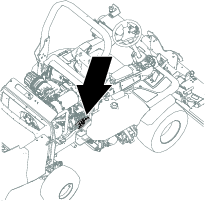
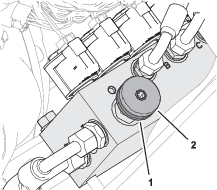
-
At the right side of the machine, loosen the lock wheel of the weight transfer manifold 1/2 turn counterclockwise while holding the hand wheel steady (Figure 29).
-
Rotate the weight transfer hand wheel (Figure 29) as follows:
-
counterclockwise to reduce weight transfer
-
clockwise to increase weight transfer
Note: The recommended setting for the weight transfer/traction assistance is to increase the weight transfer until the cutting units start to lift, then rotate the hand wheel 1/2 turn counterclockwise.
-
-
Tighten the lock wheel (Figure 29).
Clearing the Cutting Units
Warning
Never attempt to rotate the cutting units by hand. Residual pressure in the hydraulic system could cause the cutting unit(s) to rotate suddenly when you release the blockage, which may cause serious injury.
-
Always wear protective gloves and use a suitable strong wooden instrument.
-
Ensure that the wooden instrument fits between the blades and through the reel and is long enough to provide leverage to release the blockage.
-
Park the machine on a level surface.
-
Move the traction pedal to the NEUTRAL position, engage the parking brake, and shut off the cutting units.
-
Lower the cutting units to the ground or securely lock them in the transport positions.
-
Shut off the engine, remove the key, and wait for all moving parts to stop.
-
Release all stored energy devices.
-
Check that all moving parts are stationary.
-
Using a suitable strong wooden instrument, remove the blockage. Ensure that the wooden instrument is properly supported in the cutting unit and avoid using excessive force to prevent damage.
-
Remove the wooden instrument from the cutting unit before starting the engine.
-
Repair or adjust the cutting unit if required.
Operating Tips
Becoming Familiar with the Machine
Before mowing grass, practice operating the machine in an open area. Start and shut off the engine. Operate in forward and reverse. Lower and raise the cutting unit, and engage and disengage them. When you feel familiar with the machine, practice operating it up and down slopes.
Understanding the InfoCenter Engine Warnings
If while operating the machine an icon displays on the InfoCenter warning you of a condition, stop the machine immediately and correct the problem. In the table that follows includes examples of the icons that may display:
|
Icon |
Condition |
|---|---|
 |
Engine coolant is too hot. |
 |
Shut off the engine. |
 |
Stationary regeneration is required. |
 |
The power take-off is disabled. |
 |
DPF ash accumulation. |
 |
NOx control diagnosis malfunction |
Mowing Grass
To maintain the high quality of cut, keep the rotational speed of the cutting units as high as possible. This requires high engine speed.
Cutting performance is best when cutting against the lie of the grass. To take advantage this effect, alternate the mowing direction between cuts.
Take care to not leave uncut strips of grass at the overlap at points between adjacent cutting units by avoiding tight turns.
Maximizing the Quality of Cut
The quality of cut deteriorates when the forward speed is too fast. Always balance the quality of cut with the required cutting rate, and set the forward speed accordingly.
Maximizing Engine Efficiency
Do not let the engine labor. If you notice that the engine starts to labor, reduce the forward speed or increase the height of cut. Ensure that the cutting unit blades are sharp.
Driving the Machine in Transport Mode
Important: Take care when driving the machine over obstacles such as roadside curbs.Always travel at slow speed over obstacles to prevent damage to the tires, wheels, and steering system. Ensure that the tires are inflated to the recommended pressures.
Always disengage the cutting unit drive when driving the machine across areas with no grass. Grass lubricates the cutting edges while mowing. Excessive heat builds if the cutting units are run when not mowing, resulting in rapid wear. For this reason, reduce cutting speed when mowing lightly grassed areas or when the grass is dry. Be careful when driving between objects so that you do not accidentally damage the machine or the cutting units.
Using the Rear Roller Scrapers
For optimum grass discharge, remove the rear roller scrapers where conditions allow.
If mud and grass start to build up on the rollers, install the scrapers. When installing the scraper wires, tension them correctly.
After Operation
After Operation Safety
General Safety
-
Shut off the engine, remove the key, and wait for all movement to stop before you leave the operator’s position. Allow the machine to cool before adjusting, servicing, cleaning, or storing it.
-
Clean grass and debris from the cutting units, drives, mufflers, cooling screens, and engine compartment to help prevent fires. Clean up oil or fuel spills.
-
Disengage the drive to the attachment whenever you are hauling or not using the machine.
-
Maintain and clean the seat belt(s) as necessary.
-
Do not store the machine or fuel container where there is an open flame, spark, or pilot light, such as on a water heater or on other appliances.
Identifying the Tie-Down Points
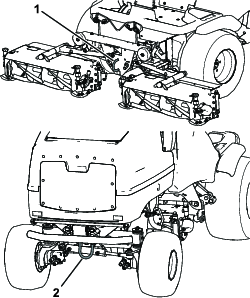
Hauling the Machine
-
Use full-width ramps for loading the machine onto a trailer or truck.
-
Tie the machine down securely.
Towing the Machine
Ensure that the towing vehicle can control the combined weight of both vehicles; refer to Specifications.
Raising the Cutting Units
Whenever possible, raise and latch the cutting units before towing the machine.
Releasing the Wheel-Motor Brakes
-
Engage the parking brake and chock the wheels of the towing vehicle.
-
Chock the front wheels of the machine.
-
Raise the platform forward; refer to Raising the Platform.
-
Remove the 2 bolts 12 x 40 mm and 2 washers 12 mm stored in the platform support rails (Figure 31).
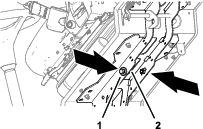
-
Connect a rigid tow bar between the front tow ring of the machine and the tow vehicle (Figure 32).
Note: If needed, use the rear tow ring of the machine to position the machine to provide clearance, and use the front tow ring to tow the machine.
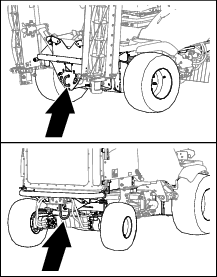
-
At the right, front wheel motor brake assembly remove the hex plug (Figure 33).
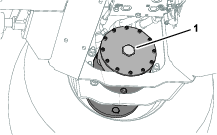
-
Assemble a bolt 12 x 40 mm and washer 12 mm into the hole at the center of the motor end plate (Figure 34).
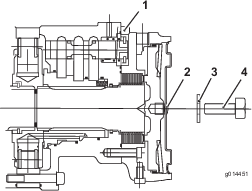
-
Tighten the bolt in the threaded hole in the brake piston until the brake releases(Figure 34).
-
Repeat steps 6 through 8 for the brake at the left side of the machine.
Bypassing the Transmission Pump
-
Use an 8 mm (5/16 inch) hex key to rotate the 2 socket head plugs for the transmission pump-relief valves counterclockwise 3 full turns (Figure 35).
Important: You must manually steer the machine while it is towed. When the engine is shut off, there is no hydraulic steering assist—steering the machine feels heavy.
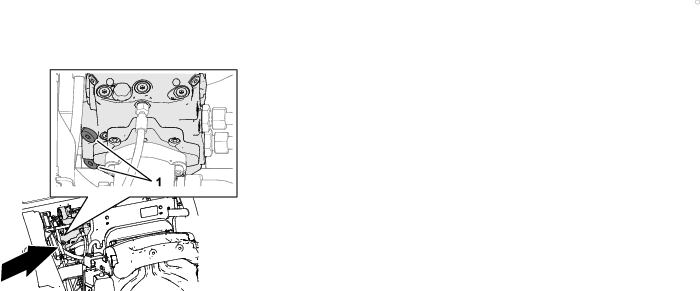
-
Lower and latch the platform; refer to Lowering the Platform.
-
Remove the wheel chocks
Towing the Machine
Important: Do not tow the machine faster than 3 to 5 km/h (2 to 3 mph) and for no longer than 3-minutes, otherwise internal damage to the transmission may occur.
-
Use the front tow ring to tow the machine.
-
Tow the machine a short distance, at slow speed, for no longer that 3-minutes.
Restoring the Transmission Pump
-
Chock the front wheels.
-
Raise the platform forward; refer to Raising the Platform.
-
Use an 8 mm (5/16 inch) hex key to rotate the 2 socket head plugs for the transmission pump-relief valves clockwise 3 turns (Figure 36).

-
Torque the 2 socket head plugs to 81 N∙m (59.7 ft-lb).
Restoring the Brakes
-
Remove the bolt 12 x 40 mm and washer 12 mm from the hole at the center of the motor end plate (Figure 37).

-
Install the hex plug into the motor end plate (Figure 38).

-
Repeat steps 1 through 2 for the brake at the other side of the machine.
-
Remove the wheel chocks.
-
Disconnect the tow bar.
Note: The transmission and brakes are ready for operation.
-
Stow the 2 bolts 12 x 40 mm and 2 washers 12 mm stored in the platform support rails (Figure 38).

-
Lower the platform; refer to Lowering the Platform.
-
Disconnect the tow vehicle.
-
Check the brake operation of the machine.
Warning
Operating the machine without the braking system working properly may cause you to lose control of the machine, resulting in serious injury to you and bystanders.
Before using the machine, ensure that the braking system operates correctly. Carry out initial checks driving the machine at slow speed. Do not operate the machine with a damaged or disconnected braking system.
Maintenance
Download a free copy of the electrical or hydraulic schematic by visiting www.toro.com/en-gb and searching for your machine from the Manuals link on the home page.
Note: Determine the left and right sides of the machine from the normal operating position.
Maintenance Safety
-
Before you leave the operator’s position, do the following:
-
Park the machine on a level surface.
-
Disengage the cutting unit(s) and lower the attachments.
-
Engage the parking brake.
-
Shut off the engine and remove the key.
-
Wait for all movement to stop.
-
-
Allow machine components to cool before performing maintenance.
-
If possible, do not perform maintenance while the engine is running. Keep away from moving parts.
-
Support the machine with jack stands whenever you work under the machine.
-
Carefully release pressure from components with stored energy.
-
Keep all parts of the machine in good working condition and all hardware tightened.
-
Replace all worn or damaged decals.
-
To ensure safe, optimal performance of the machine, use only genuine Toro replacement parts. Replacement parts made by other manufacturers could be dangerous, and such use could void the product warranty.
Recommended Maintenance Schedule(s)
| Maintenance Service Interval | Maintenance Procedure |
|---|---|
| After the first hour |
|
| After the first 10 hours |
|
| After the first 50 hours |
|
| Before each use or daily |
|
| Every 50 hours |
|
| Every 250 hours |
|
| Every 500 hours |
|
| Every 1,000 hours |
|
| Every 1,500 hours |
|
| Every 3,000 hours |
|
| Every 2 years |
|
Notation for Areas of Concern
| Inspection performed by: | ||
| Item | Date | Information |
| 1 | ||
| 2 | ||
| 3 | ||
| 4 | ||
| 5 | ||
| 6 | ||
Pre-Maintenance Procedures
Raising the Platform
Lowering the Platform
Warning
Operating the machine with the platform unlatched may cause you to lose control of the machine, resulting in serious injury to you and bystanders.
Never operate the machine without first checking that the operator platform latching mechanism is fully engaged and in good working order.
-
Lower the platform carefully (Figure 42).
Note: The gas lift cylinder helps support the platform.
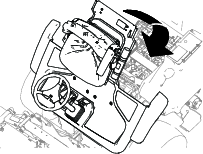
-
As the platform nears the fully lowered position, move the platform-latch handle (Figure 43) toward the front of the machine.
Note: This ensures that the latch hooks clear the locking bar.
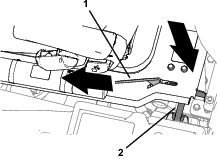
-
Fully lower the platform and move the platform-latch handle toward the rear of the machine until the latch hooks fully engage the locking bar (Figure 44).
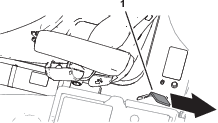
Removing the Storage Compartment
Installing the Storage Compartment
-
Align the holes on the bottom of the storage compartment with the holes in the chassis brackets.
-
Assemble the storage compartment to the machine with the 3 knobs and 3 washers (Figure 46)

-
Close the storage-compartment door.
Locating the Lift Points
Note: Use jack stands to support the machine when you lift it.
Warning
Mechanical or hydraulic jacks may fail to support the machine and cause serious injury.
Use jack stands when supporting the machine.
-
Front—under the front arm mount
-
Rear—axle tube on the rear axle
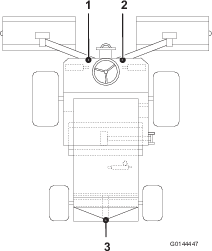
Lubrication
Greasing the Bearings, Bushings, and Pivots
| Maintenance Service Interval | Maintenance Procedure |
|---|---|
| Before each use or daily |
|
| Every 50 hours |
|
Important: Lubricate the bearings, bushings, and pivot points immediately after every washing, regardless of the service interval listed.
Grease specification: No. 2 lithium grease.
-
Use 1 pump of grease on the height-of-cut adjusters and 3 pumps of grease on all other grease fittings
-
Refer to Figure 48 for the grease fitting locations.
-
Replace any damaged grease fittings.
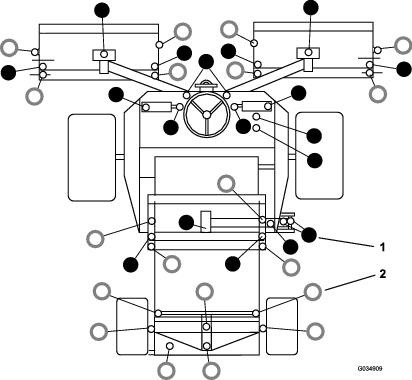
Engine Maintenance
Engine Safety
-
Shut off the engine before checking the oil or adding oil to the crankcase.
-
Do not change the governor speed or overspeed the engine.
Checking the Air Filter-Blockage Indicator
| Maintenance Service Interval | Maintenance Procedure |
|---|---|
| Before each use or daily |
|
-
Open the hood.
-
Check the air filter-blockage indicator (Figure 49).
Important: If the indicator is red, inspect the primary air filter and replace it if it is dirty or damaged; refer to Replacing the Primary Air Filter.
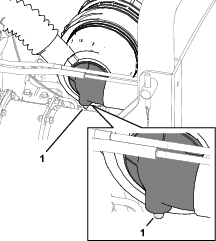
-
If the filter-blockage indicator is not red, close the hood.
Replacing the Primary Air Filter
| Maintenance Service Interval | Maintenance Procedure |
|---|---|
| Every 500 hours |
|
Check the air-cleaner body for damage that could cause an air leak. Replace the air-cleaner body if damaged. Check the whole intake system for leaks, damage, or loose hose clamps.
Note: Service the primary air filter when the filter-blockage indicator (Figure 49) is red. Changing the air filter frequently increases the chance of dirt entering the engine when the filter is removed.
Important: Be sure that the cover is seated correctly and seals with the air-cleaner body.
-
Before removing the air-filter cover, use low pressure air (40 psi, clean and dry) to help remove large accumulations of debris packed outside of the filter canister.
Note: This cleaning process prevents debris from migrating into the intake when the filter is removed.
Important: Avoid using high-pressure air which could force dirt through the filter into the intake tract.
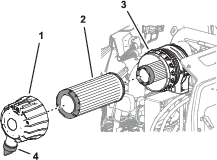
-
Remove the cover from the air-cleaner body.
-
Remove the primary air filter (Figure 50).
Important: Do not clean and reuse a used element because of possible damage to the filter element.
-
Inspect the new filter for shipping damage, checking the sealing end of the filter and the body.
Important: Do not use a damaged element.
-
Insert the new filter by applying pressure to the outer rim of the element to seat it in the canister.
Important: Do not apply pressure to the flexible center of the filter.
-
Clean the dirt ejection port located in the air-filter cover. Remove the rubber outlet valve from the cover, clean the cavity in the valve, and install the outlet valve into the air-filter cover.
-
Align the dirt ejection port air-filter cover between 5 o’clock to 7 o’clock when viewed from the end, assemble the cover to the canister, and secure the cover.
-
Check the condition of the air-cleaner hoses.
Replacing the Safety Filter
The air filter has a secondary, safety filter element inside the primary air filter to prevent dislodged dust and other items from entering the engine while changing the main element.
Replace the safety filter; never clean it.
Important: Never attempt to clean the safety filter. If the safety filter is dirty, then the primary filter is damaged. Replace both filters.
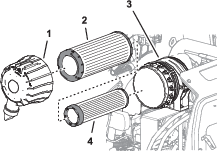
Servicing the Engine Oil
Oil Specification
Use high-quality, low-ash engine oil that meets or exceeds the following specifications:
-
API service category CJ-4 or higher
-
ACEA service category E6
-
JASO service category DH-2
Important: Using engine oil other than API CJ-4 or higher, ACEA E6, or JASO DH-2 may cause the diesel particulate filter to plug or cause engine damage.
Use the following engine oil viscosity grade:
-
Preferred oil: SAE 15W-40 (above 0°F)
-
Alternate oil: SAE 10W-30 or 5W-30 (all temperatures)
Toro Premium Engine Oil is available from your authorized Toro distributor in either 15W-40 or 10W-30 viscosity grades. See the parts catalog for part numbers.
Checking the Engine-Oil Level
| Maintenance Service Interval | Maintenance Procedure |
|---|---|
| Before each use or daily |
|
Important: Check the engine oil daily. If the engine-oil level is above the full mark on the dipstick, the engine oil may be diluted with fuel.If the engine oil level is above the full mark, change the engine oil.
The best time to check the engine oil is when the engine is cool before it has been started for the day. If it has already been run, allow the oil to drain back down to the sump for at least 10 minutes before checking. If the oil level is at or below the Add mark on the dipstick, add oil to bring the oil level to the Full mark. Do not overfill the engine with oil.
Important: Keep the engine oil level between the upper and lower limits on the oil gauge; the engine may fail if you run it with too much or too little oil.
-
Park the machine on a level surface, lower the cutting units, shut off the engine, engage the parking brake, and remove the key.
-
Unlock the engine-cover latches and open the engine cover.
-
Remove the dipstick, wipe it clean, install the dipstick into the tube, and pull it out again. The oil level should be between the FULL and ADD marks (Figure 52).
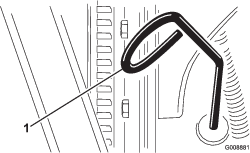
-
If the oil level is low, remove the fill cap and add oil until it is between the FULL and ADD marks (Figure 52).
Note: Do not overfill the engine.
-
Install the oil-fill cap and dipstick.
-
Close the engine cover and secure it with the latches.
Crankcase Oil Capacity
5.5 L (5.8 US qt) with the filter
Changing the Engine Oil and Filter
| Maintenance Service Interval | Maintenance Procedure |
|---|---|
| Every 500 hours |
|
-
Remove the drain plug and let the oil flow into a drain pan (Figure 53).
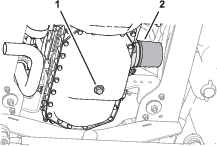
-
When all the oil is drained, install the drain plug and tighten it to 54 to 63 N∙m (39 to 47 in-lb).
-
Remove the oil filter.
-
Apply a light coat of clean oil to the oil filter gasket.
-
Thread the oil filter onto the engine until it contacts the mounting surface, and tighten the filter an additional turn.
Important: Do not overtighten the filter.
-
Add oil to the crankcase; refer to Oil Specification and Checking the Engine-Oil Level.
Servicing the Diesel-Oxidation Catalyst (DOC) and the Soot Filter
| Maintenance Service Interval | Maintenance Procedure |
|---|---|
| Every 3,000 hours |
|
If engine faults , , or display in the InfoCenter (Figure 54), clean the soot filter using the steps that follow:



-
Refer to the Engine section in the Service Manual for information on disassembling and assembling the diesel-oxidation catalyst and the soot filter of the DPF.
-
Refer to your authorized Toro distributor for diesel-oxidation catalyst and the soot filter replacement parts or service.
-
Contact your authorized Toro distributor to reset the engine ECU after you install a clean DPF.
Extended Engine Maintenance
| Maintenance Service Interval | Maintenance Procedure |
|---|---|
| Every 1,000 hours |
|
| Every 1,500 hours |
|
| Every 3,000 hours |
|
Fuel System Maintenance
Danger
Under certain conditions, fuel and fuel vapors are highly flammable and explosive. A fire or explosion from fuel can burn you and others and can cause property damage.
-
Fill the fuel tank outdoors, in an open area, when the engine is off and is cold. Wipe up any fuel that spills.
-
Do not fill the fuel tank completely full. Add fuel to the fuel tank until the level is 25 mm (1 inch) below the top of the tank, not the filler neck. This empty space in the tank allows the fuel to expand.
-
Never smoke when handling fuel, and stay away from an open flame or where spark can ignite fuel fumes.
-
Store fuel in a clean, safety-approved container and keep the cap in place.
Servicing the Water Separator
| Maintenance Service Interval | Maintenance Procedure |
|---|---|
| Before each use or daily |
|
-
Park the machine on a level surface, lower the cutting units, engage the parking brake, shut off the engine, and remove the key.
-
Place a clean container under the fuel filter.
-
Loosen the drain valve at the bottom of the filter canister and open the vent screw at the top of the canister mount.
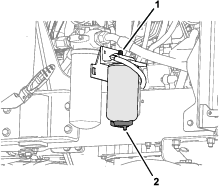
-
Tighten the drain valve at the bottom of the filter canister and close the vent screw at the top of the canister mount.
-
Prime the fuel system; refer to Priming the Fuel System.
Priming the Fuel System
Prime the fuel system under the following conditions:
-
Before starting the engine for the first time.
-
If you run out of fuel and then add new fuel to the system.
-
After performing maintenance to the fuel system, such as changing the fuel filter, draining the water separator, or replacing a fuel-system component.
To prime the fuel system, rotate the key switch to the ON position for 10 to 15 seconds to allow the electric fuel pump to prime the fuel system.
Important: Do not use the starter motor to crank the engine to prime the fuel system. You will damage the starter motor.
Replacing the Fuel-Water Filter
| Maintenance Service Interval | Maintenance Procedure |
|---|---|
| Every 500 hours |
|
Important: Replace the fuel filter canister periodically to prevent wear of the fuel injection pump plunger or the injection nozzle, due to dirt in the fuel.
-
Place a clean container under the fuel filter canister (Figure 56).
-
Drain the fuel filter canister; refer to Servicing the Water Separator.
-
Clean the area around the fuel filter and filter head (Figure 56).
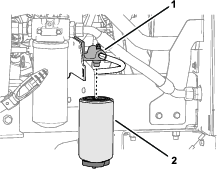
-
Remove the filter canister and clean the filter head (Figure 56).
-
Lubricate the gasket on the filter canister with clean diesel fuel.
-
Install the new filter canister by hand until the gasket contacts mounting surface.
-
Prime the fuel system; refer to Priming the Fuel System.
Servicing the Engine Fuel Filter
| Maintenance Service Interval | Maintenance Procedure |
|---|---|
| Every 500 hours |
|
Note: Refer to the engine owner's manual included with the machine for additional information.
-
Clean the area around the fuel-filter head (Figure 57).
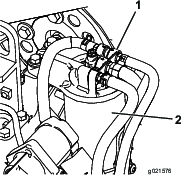
-
Remove the filter and clean the filter-head mounting surface (Figure 57).
-
Lubricate the filter gasket with clean diesel fuel.
-
Install the dry filter canister, by hand, until the gasket contacts the filter head, then rotate it an additional 1/2 turn.
-
Start the engine and check for fuel leaks around the filter head.
Checking the Fuel Lines and Connections
| Maintenance Service Interval | Maintenance Procedure |
|---|---|
| Every 500 hours |
|
Check the fuel lines and connections for deterioration, damage, or loose connections.
Fuel Pick-up Tube Screen
The fuel pick-up tube is located inside the fuel tank. The pick-up tube is equipped with a screen to help prevent debris from entering the fuel system. Remove the fuel pick-up tube and clean screen as required.
Electrical System Maintenance
Important: Before welding on the machine, disconnect both cables from the battery, both wire harness plugs from the electronic control modules, and the terminal connector from the alternator to prevent damage to the electrical system.
Electrical System Safety
-
Disconnect the battery before repairing the machine. Disconnect the negative terminal first and the positive last. Connect the positive terminal first and the negative last.
-
Charge the battery in an open, well-ventilated area, away from sparks and flames. Unplug the charger before connecting or disconnecting the battery. Wear protective clothing and use insulated tools.
Battery Maintenance
Danger
Battery electrolyte contains sulfuric acid, which is fatal if consumed and causes severe burns.
-
Do not drink electrolyte and avoid contact with skin, eyes, or clothing. Wear safety glasses to shield your eyes and rubber gloves to protect your hands.
-
Fill the battery where clean water is always available for flushing the skin.
Warning
Charging the battery produces gasses that can explode.
Never smoke near the battery and keep sparks and flames away from it.
Keep the terminals and the entire battery case clean because a dirty battery discharges slowly. To clean the battery, wash the entire case with a solution of baking soda and water. Rinse it with clear water.
Servicing the Battery
| Maintenance Service Interval | Maintenance Procedure |
|---|---|
| Every 50 hours |
|
Important: When removing the battery, always disconnect the negative (-) cable first.
Important: When installing the battery, always connect the negative (-) cable last.
Under normal operating conditions the battery does not require any further attention. If the machine has been subject to continuous use under high ambient temperature conditions, the battery electrolyte may require adding water.
-
Remove the storage compartment; refer to Removing the Storage Compartment.
-
Remove any corrosion from the battery terminals using a wire brush and to prevent further corrosion.
Note: Check the condition of the battery cables. Install new cables when current ones are showing signs of wear or damage and tighten any loose connections as necessary.
-
Apply Grafo 112X skin-over grease (Toro Part No. 505-47) or petroleum jelly to the terminals.
-
Clean the battery compartment.
-
Remove the cell covers and if needed add distilled water to a height 15 mm below the top of the battery. Install the cell covers.
-
Install the storage compartment; refer to Installing the Storage Compartment.
Checking the Electrical System
| Maintenance Service Interval | Maintenance Procedure |
|---|---|
| Every 500 hours |
|
Inspect all electrical connections and cables and replace any which are damaged or corroded. Spray a good-quality water inhibitor onto exposed connections to prevent moisture ingress.
Checking the Fuses
-
Remove the storage compartment; refer to Removing the Storage Compartment.
-
Remove the fuse-block cover (Figure 58)
Note: The fuse block is located next to the battery.
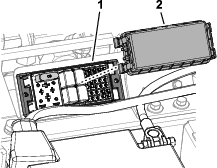
-
Check for open fuses.
Note: There are 10 fuses in the electrical system.
-
Replace any open fuse with a fuse of equal amperage capacity.
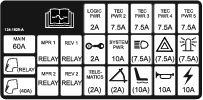
-
Install the fuse-block cover (Figure 58).
-
Install the storage compartment; refer to Installing the Storage Compartment.
Drive System Maintenance
Checking the Tire Air Pressure
| Maintenance Service Interval | Maintenance Procedure |
|---|---|
| Before each use or daily |
|
Important: Maintain correct tire pressure in all tires to ensure correct contact with the turf.
Recommended tire pressure is 1 bar (14.5 psi) for general all around use. Adjust the tire air pressures according to the following table depending on operating conditions.
| Tires | Tire Type | Recommended Tire Pressures | ||
| Turf Conditions | Road Conditions | Maximum Pressure | ||
| Front Axle | 26 x 12.0 - 12 BKT turf pattern | 0.7 bar (10 psi) | 1.4 bar (20 psi) | 1.4 bar (20 psi) |
| Rear Axle | 20 x 10.0 - 8 BKT turf pattern | 0.7 bar (10 psi) | 1.4 bar (20 psi) | 1.5 bar (22 psi) |
Checking the Torque of the Wheel Nuts
| Maintenance Service Interval | Maintenance Procedure |
|---|---|
| After the first hour |
|
| After the first 10 hours |
|
| Every 250 hours |
|
Front wheel nuts torque specification: 200 N∙m (148 ft-lb)
Rear wheel nuts torque specification: 100 N∙m (74 ft-lb)
Warning
Failure to maintain proper torque of the wheel nuts could result in personal injury.
Maintain the proper torque on the wheel nuts.
Inspecting the Transmission Control Cable and Operating Mechanism
| Maintenance Service Interval | Maintenance Procedure |
|---|---|
| Every 250 hours |
|
Check the condition and security of the cable and operating mechanism at the speed-control pedals and transmission pump ends.
-
Remove buildup of dirt, grit, and other debris.
-
Ensure that the ball joints are securely anchored and check that the mounting brackets and cable anchors are tight and free from cracks.
-
Inspect end fittings for wear, corrosion, broken springs, and replace if necessary.
-
Ensure that the rubber seals are correctly located and are in good condition.
-
Ensure that the articulating sleeves supporting the inner cable are in good condition and firmly attached to the outer cable assembly at the crimped connections. If there are any signs of cracking or detachment install a new cable immediately.
-
Check that sleeves, rods, and inner cable are free from bends, kinks, or other damage. If they are not, install a new cable immediately.
-
With the engine shut off, operate the pedal controls through the entire range and ensure that the mechanism moves smoothly and freely to the neutral position without sticking or hanging up.

Checking the Rear Wheel Toe-In
| Maintenance Service Interval | Maintenance Procedure |
|---|---|
| Every 1,000 hours |
|
-
Rotate the steering wheel to position the rear wheels straight ahead.
-
Loosen the jam nut on each end of the tie rod (Figure 61).
Note: The end of the tie rod with the external groove is a left-hand thread.
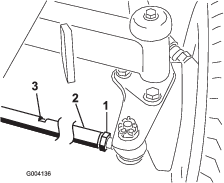
-
To pivot the wheels, rotate the tie rod to by turning it at the wrench flats (Figure 61).
-
Measure the distance between the front of the rear wheels and between the rear of the rear wheels at axle height.
Note: When the wheel alignment is correct, you should measure 6 mm (1/4 inch) or less between the front of the wheels and between the rear of the wheels.
-
Repeat steps 3 and 4 until the difference between the front and rear is 6 mm (1/4 inch) or less.
-
Tighten the jam nut on each end of the tie rod (Figure 61).
Cooling System Maintenance
Cooling System Safety
-
Swallowing engine coolant can cause poisoning; keep out of reach from children and pets.
-
Discharge of hot, pressurized coolant or touching a hot radiator and surrounding parts can cause severe burns.
-
Always allow the engine to cool at least 15 minutes before removing the radiator cap.
-
Use a rag when opening the radiator cap, and open the cap slowly to allow steam to escape.
-
Removing Debris from the Cooling System
| Maintenance Service Interval | Maintenance Procedure |
|---|---|
| Before each use or daily |
|
-
Park the machine on a level surface, lower the cutting units, shut off the engine, engage the parking brake, and remove the key.
-
Remove the ball pin from the screen latch (Figure 62)
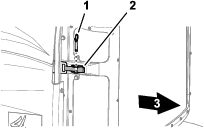
-
Unlatch the engine screen, open it, and lift it from the machine (Figure 63).
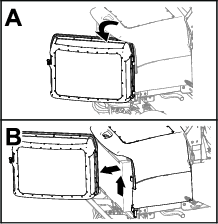
-
Clean the screens.
-
Unlatch and open the hood (Figure 64).
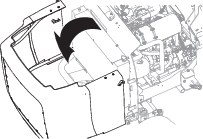
-
Thoroughly clean all debris out of the engine area.
-
Thoroughly clean both sides of the radiator and oil cooler with compressed air (Figure 65).
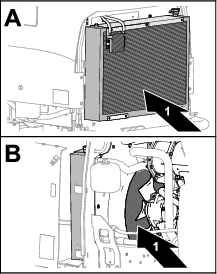
-
Close and latch the hood.
-
Assemble the screen onto the pivot pins, close the screen and secure it with the latch and ball pin.
Checking the Coolant Level
| Maintenance Service Interval | Maintenance Procedure |
|---|---|
| Before each use or daily |
|
The cooling system is filled with a 50/50 solution of water and permanent ethylene glycol antifreeze. Check the level of coolant in the expansion tank at the beginning of each day before starting the engine.
Caution
If the engine has been running, the pressurized, hot coolant can escape and cause burns.
-
Do not open the radiator cap when the engine is running.
-
Use a rag when opening the radiator cap, and open the cap slowly to allow steam to escape.
-
Check the level of coolant in the expansion tank (Figure 66).
The coolant level should be between the marks on the side of the tank.
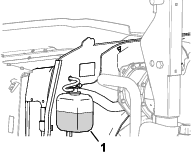
-
If the coolant level is low, remove the expansion-tank cap and replenish the system. Do not overfill.
-
Install the expansion-tank cap.
Belt Maintenance
Servicing the Alternator Belt
| Maintenance Service Interval | Maintenance Procedure |
|---|---|
| After the first 50 hours |
|
| Every 250 hours |
|
-
Apply 10 kgf (22 lb) of force against the alternator belt (Figure 67), midway between the pulleys.
Note: The belt should deflect 10 mm (3/8 inch).
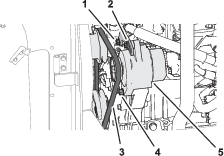
-
If the belt tension is incorrect, perform the following:
-
If belt deflection is less than 10 mm (3/8 inch), loosen the alternator pivot bolt and tension bolt (Figure 67), and reduce the belt tension.
-
If belt deflection is greater than 10 mm (3/8 inch), loosen the alternator pivot bolt and tension bolt (Figure 67), and increase the belt tension.
Note: If needed, loosen the tension bracket bolt (Figure 67).
-
-
Tighten the bolts (Figure 67).
-
Check the deflection of the belt again to ensure correct belt tension.
Hydraulic System Maintenance
Hydraulic System Safety
-
Seek immediate medical attention if fluid is injected into skin. Injected fluid must be surgically removed within a few hours by a doctor.
-
Ensure that all hydraulic-fluid hoses and lines are in good condition and all hydraulic connections and fittings are tight before applying pressure to the hydraulic system.
-
Keep your body and hands away from pinhole leaks or nozzles that eject high-pressure hydraulic fluid.
-
Use cardboard or paper to find hydraulic leaks.
-
Safely relieve all pressure in the hydraulic system before performing any work on the hydraulic system.
Checking the Hydraulic Lines and Hoses
| Maintenance Service Interval | Maintenance Procedure |
|---|---|
| Before each use or daily |
|
Check the hydraulic lines and hoses for leaks, kinked lines, loose mounting supports, wear, loose fittings, weather deterioration, and chemical deterioration. Make all necessary repairs before operating.
Hydraulic Fluid Specifications
The reservoir is filled at the factory with high-quality hydraulic fluid. Check the level of the hydraulic fluid before you first start the engine and daily thereafter; refer to Checking the Hydraulic Fluid Level.
Recommended hydraulic fluid: Toro PX Extended Life Hydraulic Fluid; available in 19 L (5 US gallon) pails or 208 L (55 US gallon) drums.
Note: A machine using the recommended replacement fluid requires less frequent fluid and filter changes.
Alternative hydraulic fluids: If Toro PX Extended Life Hydraulic Fluid is not available, you may use another conventional, petroleum-based hydraulic fluid having specifications that fall within the listed range for all the following material properties and that it meets industry standards. Do not use synthetic fluid. Consult with your lubricant distributor to identify a satisfactory product.
Note: Toro does not assume responsibility for damage caused by improper substitutions, so use products only from reputable manufacturers who will stand behind their recommendation.
| Material Properties: | ||
| Viscosity, ASTM D445 | cSt @ 40°C (104°F) 44 to 48 | |
| Viscosity Index ASTM D2270 | 140 or higher | |
| Pour Point, ASTM D97 | -37°C to -45°C (-34°F to -49°F) | |
| Industry Specifications: | Eaton Vickers 694 (I-286-S, M-2950-S/35VQ25 or M-2952-S) | |
Note: Many hydraulic fluids are almost colorless, making it difficult to spot leaks. A red dye additive for the hydraulic fluid is available in 20 ml (0.67 fl oz) bottles. A bottle is sufficient for 15 to 22 L (4 to 6 US gallons) of hydraulic fluid. Order Part No. 44-2500 from your authorized Toro distributor.
Important: Toro Premium Synthetic Biodegradable Hydraulic Fluid is the only synthetic biodegradable fluid approved by Toro. This fluid is compatible with the elastomers used in Toro hydraulic systems and is suitable for a wide-range of temperature conditions. This fluid is compatible with conventional mineral oils, but for maximum biodegradability and performance, the hydraulic system should be thoroughly flushed of conventional fluid. The oil is available in 19 L (5 US gallon) pails or 208 L (55 US gallon) drums from your authorized Toro distributor.
Checking the Hydraulic Fluid Level
| Maintenance Service Interval | Maintenance Procedure |
|---|---|
| Before each use or daily |
|
The reservoir is filled at the factory with high-quality hydraulic fluid. The best time to check the hydraulic fluid is when it is cold.
-
Park the machine on a level surface, lower the cutting units, engage the parking brake, shut off the engine, and remove the key.
-
Check the sight-level gauge on the side of the tank.
Note: The hydraulic-fluid level needs to align with the upper mark.
-
If additional hydraulic fluid is needed, remove the storage compartment; refer to Removing the Storage Compartment.
-
Clean the area around the filler neck and the cap of the hydraulic tank (Figure 68) .
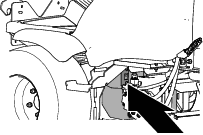
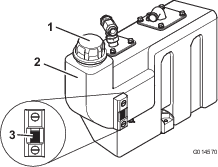
-
Remove the cap and fill the tank with the specified hydraulic fluid to the upper mark on the sight-level gauge.
Important: Do not overfill the tank with hydraulic fluid.
-
Install the cap onto the tank.
-
Install the storage compartment; refer to Installing the Storage Compartment.
Changing the Hydraulic Return Filter
| Maintenance Service Interval | Maintenance Procedure |
|---|---|
| Every 500 hours |
|
| Every 1,000 hours |
|
-
Park the machine on a level surface, lower the cutting units, shut off the engine, engage the parking brake, and remove the key.
-
Open the hood.
-
At the left side of the machine, clean the area around the filter head and place a drain pan under the filter (Figure 69).
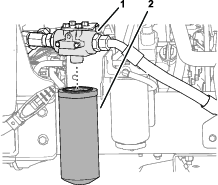
-
Remove the return filter (Figure 69).
-
Lubricate the gasket of the new return filter with clean hydraulic fluid.
-
Assemble the filter to the filter head, and tighten the filter by hand until the gasket contacts the mounting surface, then rotate it an additional 1/2 turn (Figure 69).
-
Start the engine and let it run for 2 minutes to purge air from the system.
-
Shut off the engine, remove the key, and check for leaks.
-
Close and latch the hood.
Changing the Hydraulic Fluid
| Maintenance Service Interval | Maintenance Procedure |
|---|---|
| Every 500 hours |
|
| Every 1,000 hours |
|
If the fluid becomes contaminated, contact your authorized Toro distributor to flush the system. Contaminated fluid looks milky or black when compared to clean fluid.
Draining the Hydraulic Fluid
-
Park the machine on a level surface, lower the cutting units, shut off the engine, engage the parking brake, and remove the key.
-
Remove the storage compartment; refer to Removing the Storage Compartment.
-
Align a drain pan under the hydraulic tank, remove the tank drain plug, and fully drain the hydraulic fluid (Figure 70).
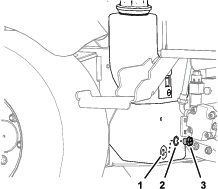
-
Install the drain plug with a new seal.
Cleaning the Strainers
Hydraulic Fluid Capacity
32 L (8.5 US gallons); refer to Hydraulic Fluid Specifications
Filling the Hydraulic Tank with Fluid
-
Fill the hydraulic tank with the specified hydraulic fluid; refer to Hydraulic Fluid Specifications and Checking the Hydraulic Fluid Level.
Important: Use only hydraulic fluids specified; other hydraulic fluids could damage the system.
-
Run the machine and operate all hydraulic systems until the hydraulic fluid is warm.
-
Check the fluid level and top up as necessary to the upper mark on the sight-level gauge.
-
Install the storage compartment; refer to Installing the Storage Compartment.
Cutting Units
Blade Safety
A worn or damaged blade or bedknife can break, and a piece could be thrown toward you or bystanders, resulting in serious personal injury or death.
-
Inspect the blades and bedknives periodically for excessive wear or damage.
-
Use care when checking the blades. Wear gloves and use caution when servicing them. Only replace or backlap the blades and bedknives; never straighten or weld them.
-
On machines with multiple cutting units, take care when rotating a cutting unit; it can cause the reels in the other cutting units to rotate.
Back Lapping the Cutting Units
Warning
Contact with the cutting units or other moving parts can result in personal injury.
-
Keep fingers, hands, and clothing away from the cutting units or other moving parts.
-
Never attempt to turn the cutting units by hand or foot while the engine is running.
Use this process to restore the sharp cutting edges to reels and bedknives which are needed for good-quality grass cutting.
This process can only removes a small amount of metal to restore the cutting edges. If the blade edges are seriously worn or damaged, remove the cutting unit and have the reels and bedknife ground again.
-
Engage the parking brake, lower the cutting units, shut off the engine, and remove the key.
-
Adjust the reels to the bedknives to obtain light contact.
-
Apply a coat of medium-grade detergent-based carborundum paste to the cutting edges of the reels with a long-handled brush.
80-grade carborundum paste Part number 0.45 kg (1 lb) 63-07-088 11.25 kg (25 lb) 63-07-086 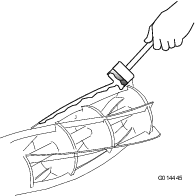
-
Sit on the operator seat, start the engine, and set the engine speed to idle.
Warning
If you touch the cutting units when the engine is running, you could be seriously injured.
-
Ensure that the area surrounding the cutting units is clear of people.
-
Keep hands and feet clear of the cutting units during the period when the mower engine is running.
-
-
Press cutting unit drive switch to the REVERSE (backlap) position for a period of time. Listen to the grinding action.
-
Operate the cutting unit drive switch to the OFF. When the cutting unit stops running, shut off the engine and remove the key.
-
Thoroughly clean the blade edges and adjust the bedknives to the reels.
-
Check that a thin piece of paper can be cut cleanly at all points along the cutting edges while rotating the reels by hand.
-
If further back lapping is necessary repeat steps 2 through 8.
-
Thoroughly clean off all traces of the carborundum paste from the reels and bedknives.
Grinding the Cutting Units
-
Grind reel blades or bedknives to correct excessively rounded or distorted reel edges or bedknife edges.
Important: Replace the bedknives at the end of their wear life.
-
Grind new blades on their holders prior to fitting.
-
When grinding reel blades or the bedknives are needed, it is essential that they are ground at the same time.
Note: The only exception to this rule is when a new reel is installed, in which case only grind the bedknife.
-
Have your authorized Toro dealer grind your reel blades and bedknives on a quality, well-maintained reel / bedknife grinding machine.
Chassis Maintenance
Inspecting the Seat Belt
| Maintenance Service Interval | Maintenance Procedure |
|---|---|
| Before each use or daily |
|
-
Inspect the seat belt for wear, cuts, and other damage. Replace the seat belt(s) if any component does not operate properly.
-
Clean the seat belt as necessary.
Checking the Fasteners
| Maintenance Service Interval | Maintenance Procedure |
|---|---|
| Before each use or daily |
|
Check the machine for loose and missing fasteners.
Note: Tighten any loose fasteners; replace any missing fasteners.
Extended Maintenance
| Maintenance Service Interval | Maintenance Procedure |
|---|---|
| Every 250 hours |
|
| Every 2 years |
|
Cleaning
Washing the Machine
Wash the machine as needed using water alone or with a mild detergent. You may use a rag when washing the machine.
Important: Do not use brackish or reclaimed water to clean the machine.
Important: Do not use power-washing equipment to wash the machine. Power-washing equipment may damage the electrical system, loosen important decals, or wash away necessary grease at friction points. Avoid excessive use of water near the control panel, engine, and battery.
Important: Do not wash the machine with the engine running. Washing the machine with the engine running may result in internal engine damage.
Storage
Storage Safety
-
Shut off the engine, remove the key, and wait for all movement to stop before you leave the operator’s position. Allow the machine to cool before adjusting, servicing, cleaning, or storing it.
-
Do not store the machine or fuel container where there is an open flame, spark, or pilot light, such as on a water heater or other appliance.
Preparing the Traction Unit
-
Park the machine on a level surface, lower the cutting units, engage the parking brake, shut off the engine, and remove the key.
-
Thoroughly clean the traction unit, cutting units, and the engine.
-
Check the tire pressure; refer to Checking the Tire Air Pressure.
-
Check all fasteners for looseness; tighten them as necessary.
-
Grease or oil all grease fittings and pivot points. Wipe up any excess lubricant.
-
Lightly sand and use touch-up paint on painted areas that are scratched, chipped, or rusted. Repair any dents in the metal body.
Preparing the Engine
-
Drain the oil from the engine and install the drain plug.
-
Remove and discard the oil filter. Install a new oil filter.
-
Fill the engine with specified motor oil.
-
Start the engine and run it at idle speed for approximately 2 minutes.
-
Shut off the engine and remove the key.
-
Flush the fuel tank with fresh, clean fuel.
-
Secure all fuel-system fittings.
-
Thoroughly clean and service the air-cleaner assembly.
-
Seal the air-cleaner inlet and the exhaust outlet with weatherproof tape.
-
Check the antifreeze protection and add a 50/50 solution of water and ethylene glycol antifreeze as needed for the expected minimum temperature in your area.
Preparing the Electrical System
-
Service the battery and cables as follows; refer to Electrical System Safety.
-
Remove the battery terminals from the battery posts.
-
Clean the battery, terminals, and posts with a wire brush and baking-soda solution.
-
Coat the cable terminals and battery posts with Grafo 112X skin-over grease (Toro Part No. 505-47) or petroleum jelly to prevent corrosion.
-
Slowly charge the battery every 60 days for 24 hours to prevent lead sulfation of the battery.
Troubleshooting
| Problem | Possible Cause | Corrective Action |
|---|---|---|
| There are areas of uncut grass at the overlap between cutting units. |
|
|
| There are full-width ridge lines in the cut across the direction of travel. |
|
|
| There are ridge lines in the cut grass, across the direction of travel, over the cutting width of 1 cutting unit. |
|
|
| There is a step in the cut grass height at the point of overlap between cutting units. |
|
|
| There are some uncut or poorly cut strands of grass. |
|
|
| There are lines of uncut or badly cut grass in the direction of travel. |
|
|
| There is scalping of the turf. |
|
|
| There is excessive bedknife wear. |
|
|
| The engine does not start with the ignition key. |
|
|
| The battery has no power. |
|
|
| The hydraulic fluid is overheating. |
|
|
| The brake system does not operate correctly. |
|
|
| There is a lack of steering. |
|
|
| There is no machine movement in forward or reverse. |
|
|
| The machine creeps forward or backward in neutral. |
|
|
| There is excessive noise in the hydraulic system. |
|
|
| After an initial period of satisfactory operation, the machine loses power. |
|
|
| A reel ‘knocks’ while rotating. |
|
|
| 1 reel rotates slowly. |
|
|
| A cutting unit fails to lift out of work. |
|
|
| The cutting units do not follow the contours of the ground. |
|
|
| The cutting units fail to start up when lowered into work. |
|
|
| The reels rotate in the wrong direction. |
|
|
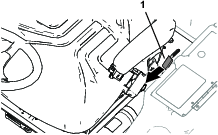
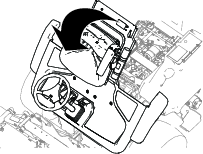
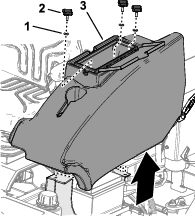
 –
Grease every 50 hours
–
Grease every 50 hours –
Grease daily
–
Grease daily